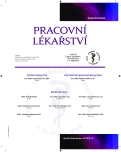Allergy to latex gloves and disinfection remedies in dentists
Authors:
Sedlatá Jurásková Eva 1; Matoušková Ivanka 2
Authors‘ workplace:
Ortodontické oddělení Kliniky zubního lékařství, Lékařská fakulta Univerzity Palackého v Olomouci a FN Olomouc
přednosta doc. MUDr. Miloš Špidlen, Ph. D.
1; Ústav preventivního lékařství, Lékařská fakulta Univerzity Palackého v Olomouci
přednostka doc. MUDr. Helena Kollárová, Ph. D.
2
Published in:
Pracov. Lék., 65, 2013, No. 3-4, s. 100-104.
Category:
Original Papers
Overview
Allergy to examination latex gloves represents a serious problem for employees in medical services as well as for some patients. The disposable examinations gloves are one of the main components of the barrier protection against transmission of infection agents in the health services. Their use for dentists is in accord with the presently valid legislation in the Czech Republic. The increased occurrence of allergy to latex is associated with the following facts: in the eighties there was a sharp increase in the use of examination gloves in health services, there were technological changes in the latex processing and new technologies were introduced with applications of new chemicals in artificial latex production. The allergy reactions can be divided in two types: Type I and Type IV. The study employed anonymous questionnaires to determine actual conditions of skin reactions associated with the use of latex examination gloves and demonstrable skin damage in connection with the use of liquid soap or alcohol disinfection preparation in performing hand hygiene in dentists. The authors addressed probands, 36 dentists with private practice and 18 dental physicians, employees of the Clinic of Dental Medicine, Medical Faculty of Palacký University and Faculty Hospital at Olomouc. In the dental physician group in private practice two out of 36 enrolled individuals reported hypersensitivity to latex examination gloves or to disinfection remedy. In 18 dental physicians of the Dental Medicine Clinic of Medical Faculty and Faculty Hospital at Olomouc, eight physicians reported hypersensitivity to latex examination gloves or to disinfection remedy. Only five dental physicians suffered from hypersensitivity to latex. Hypersensitivity to alcohol disinfection remedy was reported by three dental physicians. In four cases the simultaneous hypersensitivity to latex, face (Goa) powder and disinfection remedy for hygienic hand disinfection was reported. Dental physicians who reported hypersensitivity to some of the compounds in question belonged to the group with duration of practice for one to 10 years. One physician belonged to the group with 11–20 years of practice. Dental physicians who reported hypersensitivity to latex (6 probands) represent hypersensitivity prevalence to latex of 11.11%. A physician who reported hypersensitivity to powder in the gloves was included in this group. Hypersensitivity to some of the reported compounds was not evaluated by clinical allergist or dermatologist. In neither of these dental physicians skin tests or laboratory examinations were made.
Conclusion:
The observed prevalence of hypersensitivity to latex is 11.11 %. The results may be influenced by error associated with a small number of probands.
Keywords:
latex – latex examination gloves – allergy of Type I and IV
Sources
1. Katelaris, C., H., Widmer, R., P., Lazarus, R., M., Baldos, B. Screening for latex allergy with a questionnaire: Comparison with latex skin testing in a group of dental professionals. Aust. Dent. J., 47, 2002, 2, s. 152–155.
2. Taylor, J., Erkek, E. Latex allergy: diagnosis and management. Dermatol. Ther., 17, 2004, s. 289–301.
3. Metodický návod “Hygiena rukou při poskytování zdravotní péče”. Věstník MZ ČR 2012, částka 5, s. 15–21.
4. Leggat, P. A., Smith, D. R. Prevalence of hand dermatoses realted to latex exposure amongst dentists in Queensland, Australia. Int. Dent. J., 56, 2006, 3, s. 154–158.
5. Crippa, M. Latex exposure and gloves use in health settings: old and new issues. Med. La., 99, 2008, 2, s. 75–79.
6. Kean, T., McNally, M. Latex hypersenzitivity: a closer look at considerations for dentistry. J. Can. Dent. Assoc., 75, 2009, 4, s. 279–282.
7. Bhabha, F., Palmer, A., Nixon, R. Are reusable rubber gloves associated with latex allergy? Contact Dermatitis, 67, 2012, s. 381–382.
8. Tůmová, L. Alergeny přírodního původu – rostliny čeledi Euphorbiaceae. Praktické lékařství, 4, 2008, 5, s. 215–218.
9. Taylor, J. Latex allergy. Review of 44 cases including outcome and frequent association with allergic hand eczema. Arch. Dermatol., 132, 1996, s. 265–271.
10. Nutter, A. F. Contact urticaria to rubber. Br. J. Dermatol., 101, 1979, s. 597–598.
11. Ownby, D. R. A history of latex allergy. J. Allergy Clin. Immunol., 110, 2002, 2 Suppl., S27–32.
12. Crippa, M., Balbiani, L., Baruffini, A., Belleri, L. et al. Consensus Document. Update on latex exposure and use of gloves in Italian health care settings. Med. Lav., 99, 2008, 5, s. 387–99.
13. Hamann, C. P., dePaola, L. G., Rodgers, P. A. Occupation--related allergies in dentistry. J. Am. Dent. Assoc., 136, 2005, 4, s. 500–510.
14. Novotná, B. Alergie na latex. http://www.alergieimunita.cz.
15. Guggenheimer, J., Barket, S., Oakley, M., Close, J. Self-report of latex allergy by patients visiting a dental clinic. Compend. Contin. Educ. Dent., 33, 2012, 10, s. E150-6.
16. de Groot, H., Patiwael, J., A., de Jong, N., Burdorf, A., van Wijk, R., G. Research into senzitization and allergies to altex: results after 10 years of the use of powder-free latex gloves. Ned. Tijdschr. Geneeskd., 157, 2013, 10, A5835.
17. Ricci, G., Piccino, V., Calamelli, E., Giannetti, A., Pession, A. Latex-fruit syndrome in Italian children and adolescents with natural rubber latex allergy. Int. J. Immunopathol. Pharmacol., 26, 2013, 1, s. 263–268.
18. Wrangsjö, K., Boman, A., Lidén, C., Meding, B. Primary prevention of latex allergy in healthcare – spectrum of strategies including the European glove standardization. Contact. Dermatitis, 66, 2012, s. 165–171.
Labels
Hygiene and epidemiology Hyperbaric medicine Occupational medicineArticle was published in
Occupational Medicine

2013 Issue 3-4
Most read in this issue
- Syndrome of carpal tunnel
- Hypertension disease and health capability for work
- Health risks of exposure to dust at work
- Effects of glass fibers on selected parameters of respiratory tract in experimental conditions
